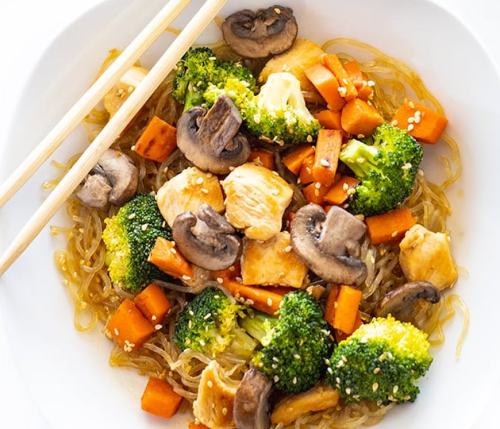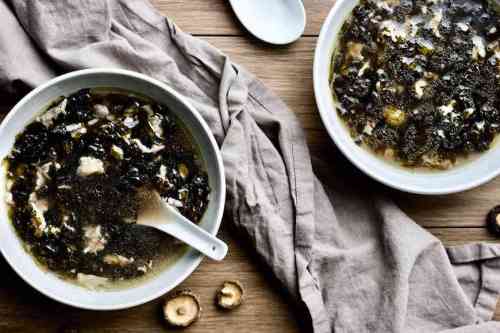“Eat more vegetables” is healthy eating 101; you don’t have to know all that much about wellness to know that filling your plate with a wide range of veggies from the produce section is a pretty darn healthy way to live. But even people who consider themself nutrition pros can forget about a subgroup of plants that’s super nutrient-dense: sea vegetables.
Experts in This Article
registered dietitian and longevity nutritionist
While sea vegetables are largely overlooked in the typical American diet, they’re staples in Asian cuisine in countries like Japan, China, and Korea. Among one of the most nutrient-rich sea vegetables popular in these regions is kelp, a type of seaweed. Kelp grows in shallow saltwater along the coastline. Here, registered dietitian Kim Melton, RD, explains the benefits of kelp. Plus, get ideas for how to cook with it.
Kelp benefits every healthy eater should know
1. Consuming kelp in moderation is good for your thyroid
According to Melton, kelp is high in iodine, which is used in the production of thyroid hormones. The connection between iodine deficiency and thyroid disease has been long established. Women should aim to get 150 micrograms of iodine a day (more if they’re pregnant or breastfeeding) and kelp is one of the best sources of the nutrient, providing over 11 percent of the recommended daily total in just one serving. But this benefit comes with a big PSA: According to the National Institutes of Health, getting over 1,100 micrograms a day is too much and is actually not good for thyroid health.
2. It supports a healthy metabolism
According to Melton as well as scientific research, the thyroid plays a key role in maintaining a healthy metabolism, so consuming kelp in moderation (which supports thyroid health) comes with this added benefit. The thyroid also plays a crucial role in maintaining enough energy, so if you find yourself feeling sluggish on a regular basis, eating more kelp could help you feel more energized.
3. Consuming kelp can help with muscle function and recovery
Not only can eating kelp help you power through a workout, it can help on the recovery front, too. “It has high amounts of magnesium, which is necessary for several biochemical reactions in the body,” Melton explains. As an electrolyte, it keeps muscles functioning properly (specifically, it helps them relax)—a definite must for any workout. One study found that magnesium helped professional cyclists better recover from muscle damage. In these ways, kelp is definitely an underrated food for athletes.
4. It’s good for your immune system
Melton also points out that kelp contains vitamin C, with 3 milligrams per serving. (You want to aim to get 75 milligrams a day.) Sure, it’s just a drop in the bucket, but every little bit helps, and getting enough vitamin C directly benefits the immune system.
5. Eating kelp regularly can lower your risk for strokes and heart disease.
“Kelp also contains 45 percent of the daily value for folate,” Melton says. Here’s why that’s such a big deal: Folate is directly linked to lowering the risk for strokes, heart disease, hearing loss, and gum disease. (It’s also a crucial nutrient for prenatal health.) A good goal is to aim to get 300 to 400 milligrams a day.
6. Kelp is a good source of iron.
One common concern for people who stick to a vegan, vegetarian, or plant-based diet is not getting enough iron. Great news: One serving of kelp has 16 percent of the iron you need for the whole day. This is another reason why eating kelp can help you feel more energized.
While kelp benefits are numerous, Melton says there are some risks of consuming kelp in high quantities. “When consumed in the small amounts typically found in food, kelp is most likely safe. But it may contain high amounts of naturally occurring heavy metals and iodine, which may be detrimental to health if too much is eaten or taken in supplement form,” she says. For this reason, it may be better to consume kelp in its natural food state than in supplement or powder form (which would be more concentrated). “Also, if someone has a kidney condition, thyroid condition, or are pregnant or breastfeeding, they should avoid kelp,” Melton adds.
If you’ve never cooked with kelp before but want to start eating more of it to benefit from its many nutrients, keep reading for some ideas that will get you started.
How to cook with kelp

1. Chinese seaweed salad
Modern Chinese food recipe creator and blogger Maggie Zhu says this vegan, seaweed salad is one of her go-to meals during hot, summer months. “It is made with tender and meaty seaweed strips, mixed in a savory and sour sauce and finished up with garlic-infused hot oil,” she says. “When it’s too hot to make stir-fried veggies, my mom usually serves this quick cold appetizer with congee and dumplings.” Mouth watering yet? Click through for the recipe.
This recipe contains lots of garlic—and that’s definitely a good thing. Watch the video below to find out why:

2. Kelp noodle salad with peanut dressing
If you prefer a peanut sauce over a garlicky one, this recipe is right up your ally. Here, kelp is used in place of noodles for a lower-carb alternative, with shredded carrots and green onions mixed right in. The whole shebang is topped off with a creamy peanut sauce. Add your go-to protein and this dish works as an entree.

3. Sesame kelp noodles
Kelp tastes just as yummy in warm dishes as it does in cold ones. In this keto-approved recipe, it’s mixed with broccoli, carrots, mushrooms, and chicken and topped with a slightly sweet sesame sauce. An added perk: it comes together in less than 30 minutes.

4. Beef seaweed soup
Korean food blogger and recipe creator Holly Elkins loves using fresh kelp in her soups because of its soft, velvety texture it takes on when cooked in the broth. Because kelp can be a bit chewy, she recommends cutting it up into small pieces so it’s easier to eat. Make a big batch of this soup and you can feed the whole fam—or eat it yourself for a few days in a row.

5. Seaweed egg drop soup
Another soup to add your kelp to is this seaweed egg drop soup. “I just can’t sing enough praises to this nourishing soup,” recipe creator and Yang’s Nourishing Kitchen creator Yang says. “In fact, it has been requested over and over again at our house by my 8-year-old. Even my Canadian-born husband who has a very conservative tastebud and would never drink any of my bone broth straight up, kept going back for seconds.” Her secret? Using shiitake ginger chicken bone broth as a base, which makes everything added to it brimming with flavor.
Did you make one of these recipes or have another favorite way to cook with kelp? Share it in Well+Good’s Cook With Us Facebook group.
Sign Up for Our Daily Newsletter
Get all the latest in wellness, trends, food, fitness, beauty, and more delivered right to your inbox.
Got it, you've been added to our email list.










